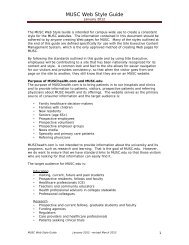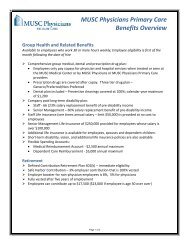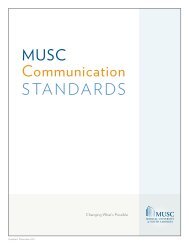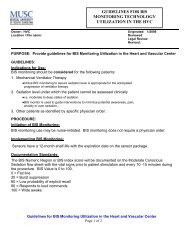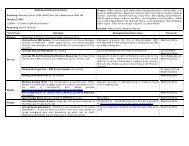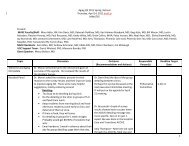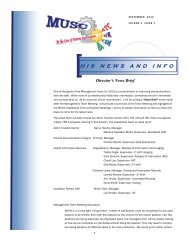<strong>Fall</strong> prevention <strong>in</strong> older adults Reviewsa. Acetam<strong>in</strong>ophen alone on a regular or as-needed scheduleb. Hydrocodonec. Tramadold. Fentanyl3. In place of her zolpidem, you recommend which of<strong>the</strong> follow<strong>in</strong>g?a. No naps after mealsb. Activities to prevent sleep after mealsc. If zolipdem is needed, hold until 11:00 pm to midnightd. All of <strong>the</strong> above alternatives are correct.4. If <strong>the</strong> patient had been tak<strong>in</strong>g o<strong>the</strong>r psychotropicmedications such as anxiolytics and/or antipsychotics,her fall risk could be decreased by which of <strong>the</strong>follow<strong>in</strong>g?a. Abruptly stopp<strong>in</strong>g all psychotropic drugsb. Stepwise discont<strong>in</strong>uance of her psychotropic drugs(i.e., one drug at a time)c. Careful taper<strong>in</strong>g of each psychotropic drug to avoidwithdrawal reactionsd. Alternatives b and c are correct.Answer key: 1. d; 2. a; 3. d; 4. dEvidence <strong>for</strong> medication association withfalls and fracturesA study of physical and pharmacologic “restra<strong>in</strong>t” of 307nurs<strong>in</strong>g home patients with dementia showed that 43% to 45%of residents received medications that could be viewed as pharmacologicrestra<strong>in</strong>ts. Residents with physically abusive behavior,<strong>in</strong>frequent family visits, and severe cognitive impairment(i.e., lack of recall or orientation to time, place, or person) weremore likely to receive pharmacologic restra<strong>in</strong>ts. 9 An earlier1-year study of 33,351 Ill<strong>in</strong>ois nurs<strong>in</strong>g home residents foundthat 60% received at least one psychotropic medication dur<strong>in</strong>gthat year. 10 In 4,501 cases of hip fracture among ambulatorypatients 65 years of age or older, 11 BZs with a longer half-lifehave been associated with a greater risk of falls and hip fracturecompared with BZs with a shorter half-life.Self-assessment questions5. The nurs<strong>in</strong>g home patient with which of <strong>the</strong> follow<strong>in</strong>gmay be more likely to receive pharmacologic “restra<strong>in</strong>ts”with psychotropics?a. Physically abusive behaviorb. Infrequent family visitsc. Severe cognitive impairmentd. All of <strong>the</strong> above alternatives are correct.6. Severe cognitive impairment may <strong>in</strong>volve lack of patientrecall or orientation to which of <strong>the</strong> follow<strong>in</strong>g?a. Timeb. Placec. Persond. All of <strong>the</strong> above alternatives are correct.Answer key: 5. d; 6. dBoth long- and shorter-act<strong>in</strong>g BZs markedly <strong>in</strong>crease <strong>the</strong>risk of falls. Serum diazepam blood levels have been directlycorrelated with <strong>the</strong> <strong>in</strong>cidence of falls. 12 Even shorter-act<strong>in</strong>gBZs (e.g., triazolam, oxazepam) given more often than one totwo times per week have been associated with <strong>in</strong>creased fallrisk. 13 A study of <strong>the</strong> sensitivity of elderly <strong>in</strong>dividuals to triazolamfound that pharmacok<strong>in</strong>etic ra<strong>the</strong>r than pharmacodynamicdifferences between older and younger patients expla<strong>in</strong>ed <strong>the</strong>greater sensitivity to <strong>the</strong> drug. Peak serum triazolam concentrationwas approximately 50% higher and triazolam clearance50% lower <strong>in</strong> <strong>the</strong> elderly versus <strong>the</strong> younger group of patients. 14Both antipsychotics and antidepressants also have been shownto <strong>in</strong>crease fall risk. 15 An association between antihistam<strong>in</strong>es,narcotic analgesics, anticonvulsants, metoclopramide, antihypertensives,and falls <strong>in</strong> those tak<strong>in</strong>g o<strong>the</strong>r multiple psychoactive(i.e., both with and without psychotropics) medicationsalso has been reported. 16–20 The risk of falls is doubled <strong>for</strong> eachpsychotropic added to <strong>the</strong> patient’s drug regimen, both with andwithout o<strong>the</strong>r psychoactive medications (e.g., antihistam<strong>in</strong>es,narcotic analgesics, anticonvulsants, metoclopramide, antihypertensives).24–28Self-assessment questions7. Both long- and shorter act<strong>in</strong>g BZs have been shownto <strong>in</strong>crease fall risk.a. Trueb. False8. <strong>Fall</strong> risk has been shown to be <strong>in</strong>creased by both s<strong>in</strong>gleand multiple agent use of which of <strong>the</strong> follow<strong>in</strong>g?a. Anxiolyticsb. Antipsychoticsc. Antidepressantsd. All of <strong>the</strong> above alternatives are correct.9. <strong>Fall</strong> risk has been shown to be <strong>in</strong>creased by which of<strong>the</strong> follow<strong>in</strong>g?a. S<strong>in</strong>gle psychoactivesb. Multiple psychoactivesc. Alternative a or b is correct with or without psychotropicdrugs.d. All of <strong>the</strong> above alternatives are correct.10. <strong>Fall</strong> risk <strong>in</strong>creases by roughly how much <strong>for</strong> each psychotropicadded to a patients drug regimen?a. One-halfb. Two timesc. Three timesd. Four timesAnswer key: 7. a; 8. d; 9. d; 10. b<strong>Medication</strong> <strong>in</strong>terventions and fallsBeneficial changes <strong>in</strong> psychotropic medications 17 and <strong>the</strong>multidiscipl<strong>in</strong>ary <strong>in</strong>terventions of nurses, consultant pharmacists,and attend<strong>in</strong>g cl<strong>in</strong>icians to reduce falls, <strong>in</strong>juries, andJournal of <strong>the</strong> American Pharmacists Association www.japha.org M a y /Ju n 2009 • 49:3 • JAPhA • e75
Reviews <strong>Fall</strong> prevention <strong>in</strong> older adultscosts 18–20 are also important means of fall prevention. In onestudy, buspirone <strong>in</strong>tervention <strong>in</strong> place of BZs and/or antipsychotics,careful drug withdrawal by stepwise discont<strong>in</strong>uancewith taper<strong>in</strong>g of 10% to 25% of <strong>the</strong> dose per week, or both alsohave been shown to decrease falls by 70% and improve cognitioncompared with similar patients. 17 The provisions of <strong>the</strong>Omnibus Budget Reconciliation Acts of 1987 and 1990 on appropriateuse of psychotropic drugs <strong>in</strong> <strong>the</strong> United States mandateat least two to three taper<strong>in</strong>g attempts of anxiolytics andantipsychotic psychotropics with<strong>in</strong> <strong>the</strong> first 6 to 12 months ofplacement with<strong>in</strong> a nurs<strong>in</strong>g facility. Effective October 1, 2008,Medicare no longer reimburses <strong>for</strong> falls occurr<strong>in</strong>g <strong>in</strong> acute caresett<strong>in</strong>gs, as a “hospital-acquired condition.” 21 The newest Centers<strong>for</strong> Medicare & Medicaid Services (CMS) guidel<strong>in</strong>es stress<strong>the</strong> need <strong>for</strong> gradual reduction of all psychotropic medicationdoses, <strong>in</strong>clud<strong>in</strong>g buspirone, unless patient dementia or o<strong>the</strong>rneuropsychiatric illness worsens dur<strong>in</strong>g attempts at taper<strong>in</strong>g.Examples of <strong>the</strong> concept of adverse effects on rapid or suddenversus gradual drug withdrawal <strong>in</strong>clude seizures with BZs, tardivedysk<strong>in</strong>esia or return of schizophrenia signs and symptomswith antipsychotics, and seroton<strong>in</strong> syndrome and worsen<strong>in</strong>g ofdepression with rapid withdrawal of antidepressants. See www.cms.hhs.gov <strong>for</strong> <strong>the</strong> latest CMS guidel<strong>in</strong>es <strong>for</strong> medications.A meta-analysis of 57 studies on <strong>the</strong> contribution of psychotropicdrugs to falls <strong>in</strong> older patients concluded that a small butconsistent association exists between <strong>the</strong> use of most classesof drugs and falls. The meta-analysis did not consider or def<strong>in</strong>e<strong>in</strong>appropriate polypharmacy. 22 <strong>Fall</strong>s were second only to nonsteroidalanti-<strong>in</strong>flammatory drug (NSAID) adverse drug reactionsas causes <strong>for</strong> adverse drug reaction hospitalizations from<strong>the</strong> long-term care facility. 23 A 1966–1999 review of psychotropicsand falls suggested that all psychotropics may <strong>in</strong>crease <strong>the</strong>risk of falls and that each additional agent may <strong>in</strong>crease <strong>the</strong>overall risk by a factor of 2.0 per psychotropic. 24 A communitybased6-month study of 305 male veterans (age 70–104 years)us<strong>in</strong>g psychoactive CNS-active medications were screenedat study entry <strong>for</strong> mobility, cognition, and depression. CNSactivemedications were categorized as BZs, o<strong>the</strong>r sedative–hypnotics, neuroleptics, tricyclic antidepressants, and opioidanalgesics. Patients were prospectively followed <strong>for</strong> 6 monthsto monitor falls; at <strong>the</strong> end of this time period, patients wereclassified as fallers (at least one fall) or nonfallers. The relationshipbetween CNS-active drug use and falls was exam<strong>in</strong>edus<strong>in</strong>g multivariable analyses. The risk of falls was significantlygreater <strong>in</strong> CNS-active medication users compared with nonusers.Adjusted odds ratio (OR) was 1.54 (95% CI 1.07–2.22)<strong>for</strong> one CNS-active drug and 2.37 (1.14–4.94) <strong>for</strong> two or moreagents. In community-dwell<strong>in</strong>g elderly, use of multiple CNS-activemedications is associated with enhanced fall liability comparedwith use of one CNS-active drug. 25Inappropriate polypharmacy and multiplepsychoactive drugsMultiple psychotropic and psychoactive drugs should betaken <strong>in</strong>to account when fall <strong>in</strong>terventions are evaluated, andreduction <strong>in</strong> total psychotropic and psychoactive drug load mayreduce fall occurrence and recurrence. 26–28 Simply put, eachadditional psychotropic doubled <strong>the</strong> rate of falls, as suggestedby an earlier review 24 and research. 26–28 An earlier study <strong>in</strong> thispopulation <strong>in</strong>dicated that those who had psychotropic drugs tapered,changed to o<strong>the</strong>r agents, and/or discont<strong>in</strong>ued had fewerfalls and <strong>in</strong>juries and less cognitive decl<strong>in</strong>e over 1 year. 17 A differencewas observed <strong>in</strong> <strong>the</strong> mean Reisberg global deteriorationscale 29 <strong>in</strong> those with a diagnosis of dementia between usersof psychotropic drugs (5.8 on 7-po<strong>in</strong>t scale) and those taperedto nonuse of psychotropic drugs (4.7) <strong>in</strong> <strong>the</strong> groups at <strong>the</strong> beg<strong>in</strong>n<strong>in</strong>gof <strong>the</strong> study. 17The most recent f<strong>in</strong>d<strong>in</strong>g is that all causes of hospitalizationof <strong>the</strong> older adult from long-term care are directly proportionalto <strong>the</strong> total psychoactive drug load. 28 The recent black boxwarn<strong>in</strong>g relabel<strong>in</strong>g of all antipsychotics states that this classof medications should not be used <strong>for</strong> long periods <strong>in</strong> patientswith dementia because of greater risk of death—more evidencethat <strong>the</strong>se drugs have high risk <strong>for</strong> <strong>the</strong> older adult. Pharmacistsshould review <strong>the</strong>se black box warn<strong>in</strong>gs on antipsychotic package<strong>in</strong>serts and patient education materials or at <strong>the</strong> Food andDrug Adm<strong>in</strong>istration drug safety website (www.fda.gov/medwatch/safety).Anemia and vitam<strong>in</strong> D deficiency and fallsIn community-dwell<strong>in</strong>g elderly, anemia is associated witha number of health-related functional decl<strong>in</strong>es, such as frailty,disability, and muscle weakness. These may contribute to falls,which, <strong>in</strong> <strong>the</strong> elderly, result <strong>in</strong> serious <strong>in</strong>juries <strong>in</strong> perhaps 10%of cases. Whe<strong>the</strong>r anemia <strong>in</strong>creased <strong>the</strong> risk of <strong>in</strong>jurious falls <strong>in</strong>an elderly population was <strong>in</strong>vestigated us<strong>in</strong>g health <strong>in</strong>suranceclaims and laboratory test results data from January 1999 toApril 2004 <strong>for</strong> 47,530 <strong>in</strong>dividuals 65 years of age or older enrolled<strong>in</strong> more than 30 managed care plans. 45Anemia <strong>in</strong> nurs<strong>in</strong>g home residents appears to be underrecognized.For residents older than 70 years, <strong>the</strong> prevalence ofanemia <strong>in</strong> one study <strong>for</strong> both men (Hb





